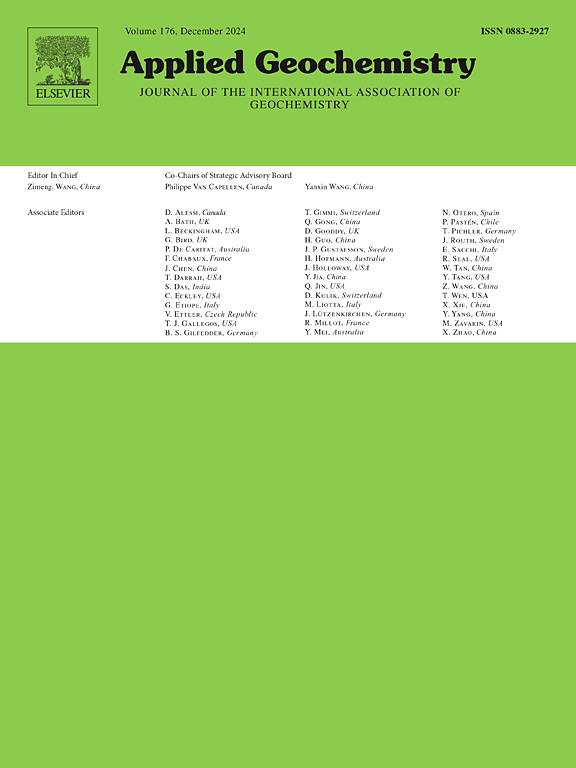A 3.5-year rainfall isotope records from northwestern Madagascar featuring 17Oexcess and implication for paleoclimate research
IF 3.1
3区 地球科学
Q1 GEOCHEMISTRY & GEOPHYSICS
引用次数: 0
Abstract
The lack of modern rainfall stable isotope datasets can leave a knowledge gap in paleoclimate reconstructions using climate sensitive archivers like stalagmites. This is the case of the growing number of paleoclimate records from Anjohibe Cave, where no local rainfall data has been available. This paper reports the first modern rainfall stable isotopes of hydrogen (δ2H and d-excess) and oxygen (δ17O and δ18O), highlighting a novel 17Oexcess proxy, spanning 3.5 years of collection from Mahajanga, the closest city of Anjohibe. These data are compared to the only prior existing rainfall isotope data from Madagascar, which was collected from the capital, Antananarivo. Interpretation of the results was helped with model simulations using ERA5T reanalysis and HYSPLIT back trajectory models. Overall, the rainfall data provide better insights on hydrological processes in Mahajanga, including a better constrain on the latitudinal migration of the Inter-Tropical Convergence Zone (ITCZ) and its impact on the kinetic and equilibrium isotopic effect that is best observed in both d-excess and 17Oexcess.
Results show that rainfall δ18O (ranging between −7.9 and + 3.9‰, vs. VSMOW) and δ2H (ranging between −49.8 and + 19.7 ‰, vs. VSMOW) from Mahajanga fit within the Global Meteoric Water Line, and they are best explained by the amount effect. However, both d-excess and 17Oexcess are kinetically affected by evaporation for months receiving <1000 mm of rainfall. These months represents the onset and termination of a rainy summer season, when the ITCZ is positioned further north. Above 1000 mm, both values plateaued at ∼15 ‰ and at ∼20 per meg, respectively, regardless of the amount. These values seem to represent the regional equilibrium value for d-excess and 17Oexcess in Mahajanga, when the air is moist during the southward visit of the ITCZ. It is also noted that Mahajanga 17Oexcess values are at the lower spectrum relative to the global 17Oexcess values (20–30 per meg), which are currently biased toward more northern hemisphere datasets. Anjohibe Cave drip waters (varying between −5.6 and −2.1‰ vs. VSMOW for δ18O and between −33.9 and −8.3 ‰ vs. VSMOW for δ2H), on the other hand, reflect more mixing of the rainfall values due to epikarst storage effects. Calculation of the isotopic fractionation factor between stalagmite and the drip waters in Anjohibe Cave also suggests a good fit with the global fractionation value, 1000ln18α = 16.89 ± 0.62 × 103/T(K) – 27.41 ± 2.14, and serves as an excellent motivation to develop future 17Oexcess records from stalagmites in the region.
马达加斯加西北部3.5年降水同位素记录的17o过量及其古气候研究意义
缺乏现代降雨稳定同位素数据集可能会在利用气候敏感档案(如石笋)重建古气候方面留下知识空白。这就是来自Anjohibe洞穴的越来越多的古气候记录的情况,那里没有当地的降雨数据。本文首次报道了现代降雨中氢(δ2H和d-excess)和氧(δ17O和δ18O)的稳定同位素,强调了一个新的17o -excess代用物,该代用物来自最近的Anjohibe市Mahajanga,收集时间长达3.5年。这些数据与马达加斯加唯一现有的降雨同位素数据进行了比较,这些数据是从首都塔那那利佛收集的。利用ERA5T再分析和HYSPLIT反轨迹模型进行模型模拟,有助于对结果进行解释。总体而言,降雨数据为Mahajanga的水文过程提供了更好的见解,包括更好地约束热带辐合带(ITCZ)的纬向迁移及其对动力学和平衡同位素效应的影响,这种影响在d-excess和17o -excess中都得到了最好的观察。结果表明,Mahajanga降水δ18O(相对于VSMOW在−7.9‰~ + 3.9‰之间)和δ2H(相对于VSMOW在−49.8‰~ + 19.7‰之间)与全球大气水线相吻合,且最适合用量效应来解释。然而,d-excess和17o -excess在动力上都受到接收1000 mm降水的月份蒸发的影响。这几个月代表了夏季多雨季节的开始和结束,这时ITCZ位于更北的位置。在1000 mm以上,无论用量如何,这两个值分别稳定在~ 15‰和~ 20 / meg。这些值似乎代表了Mahajanga的d-excess和17o -excess的区域平衡值,当空气在ITCZ向南访问期间是潮湿的。值得注意的是,Mahajanga 17Oexcess值相对于全球17Oexcess值(20-30 / meg)处于较低的光谱,目前偏向于更多的北半球数据集。另一方面,Anjohibe洞穴滴水(δ18O值与VSMOW值的比值在- 5.6 ~ - 2.1‰之间,δ2H值与VSMOW值的比值在- 33.9 ~ - 8.3‰之间)反映了表层岩溶储层作用下降雨值的混合。石笋与Anjohibe洞滴水之间的同位素分馏系数计算结果与全球分馏值(1000ln18α = 16.89±0.62 × 103/T(K) - 27.41±2.14)吻合良好,为今后开发该地区石笋的17o过量记录提供了良好的动力。
本文章由计算机程序翻译,如有差异,请以英文原文为准。
求助全文
约1分钟内获得全文
求助全文
来源期刊

Applied Geochemistry
地学-地球化学与地球物理
CiteScore
6.10
自引率
8.80%
发文量
272
审稿时长
65 days
期刊介绍:
Applied Geochemistry is an international journal devoted to publication of original research papers, rapid research communications and selected review papers in geochemistry and urban geochemistry which have some practical application to an aspect of human endeavour, such as the preservation of the environment, health, waste disposal and the search for resources. Papers on applications of inorganic, organic and isotope geochemistry and geochemical processes are therefore welcome provided they meet the main criterion. Spatial and temporal monitoring case studies are only of interest to our international readership if they present new ideas of broad application.
Topics covered include: (1) Environmental geochemistry (including natural and anthropogenic aspects, and protection and remediation strategies); (2) Hydrogeochemistry (surface and groundwater); (3) Medical (urban) geochemistry; (4) The search for energy resources (in particular unconventional oil and gas or emerging metal resources); (5) Energy exploitation (in particular geothermal energy and CCS); (6) Upgrading of energy and mineral resources where there is a direct geochemical application; and (7) Waste disposal, including nuclear waste disposal.
 求助内容:
求助内容: 应助结果提醒方式:
应助结果提醒方式:


